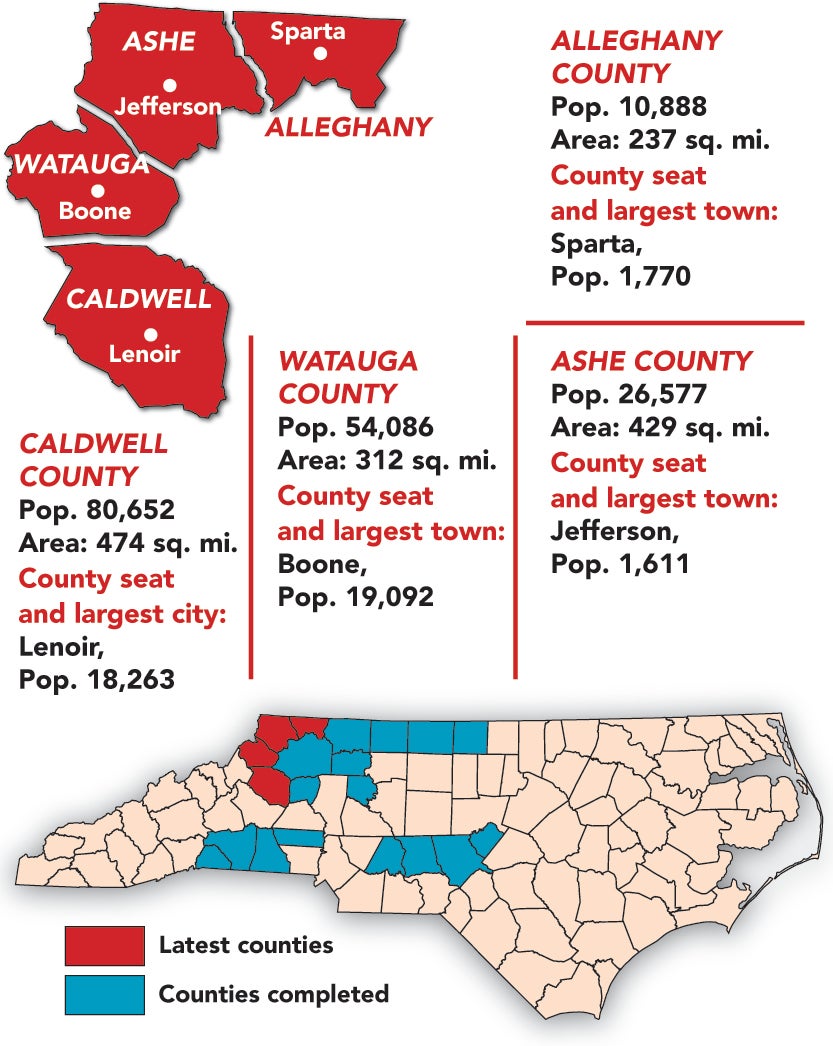DAVID FREEZE COLUMN: Heading to the high country
Editor’s note: David Freeze is a runner, running coach and long-distance cyclist from China Grove in Rowan County. He has started a challenge to run in a few miles in every county seat in all 100 N.C. counties.
My quest for more county seats across North Carolina continued on April 8.
I drove northwest to Sparta to start the day. Sparta is the county seat of Alleghany County and has a clean, small-town feel. Sparta is known most recently for an earthquake that occurred there on Aug. 9, 2020. Registering 5.1 on the Richter scale, this was the largest earthquake in North Carolina in 104 years and second largest ever.

David Freeze
Notable buildings along Main Street include the 1904 courthouse and a historical theatre that still hosts weekly community musical picking events as the Alleghany Jubilee. New to me and interesting is the promotion of Historic U.S. 21, Sparta’s Main Street, as an easier way to travel from the Great Lakes to Florida. The same distance as interstate highway travel, U.S. 21 is more scenic and fun.
Sparta is also on the Daniel Boone Highway and is gearing up to host a Fried Apple Pie Festival on May 6. Interesting too was the Sparta Presbyterian Church’s clothesline of free for the taking handmade toboggans for those in need of warmth. A mural honors country singer Del Reeves, Sparta’s most famous past resident.
I drove on scenic byways toward Jefferson, county seat of Ashe County, while listening to AM radio gospel hymns and farm reports. N.C. highways 18 and 88 took me past Christmas tree farms, one after another.
Jefferson is the smaller and less active sibling of next-door West Jefferson, a tourist destination in itself. Jefferson has the stately 1904 courthouse, now a museum. Designated as the county seat in 1799, it was named for then vice president and future president Thomas Jefferson. The New River, one of the oldest rivers in the world, flows through the town.
Next stop was Boone, county seat of Watauga County and a town I’ve visited often earlier in life but not recently. Home of Appalachian State University, Boone has a thriving downtown of trendy businesses along busy King Street.
I looked forward to grabbing something for a quick lunch there and settled for two fantastic bagels at Boone Bagelry. Boone is named for Daniel Boone who camped several times in the current location of the downtown area. His nephews were members of the still existing Three Forks Baptist Church.
Two Boone-related area attractions draw tourists regularly. The outdoor drama “Horn in the West” depicts Daniel Boone’s contribution to those seeking freedom from British tyranny in the area and has been done every year since 1952. Boone had a hunting camp and a cabin in the area from about 1767-1773.
Tweetie’s East Tennessee and Western North Carolina Railroad had tracks through the present site of ASU. A severe flood in 1940 damaged the tracks and it was decided to not replace them. The rain damage came from a stalled hurricane and left Boone isolated for days from the outside world as bridges were washed away and telephone service interrupted. At least 16 people died in the flooding.
Most of the people I saw on the streets were students although Boone is the center of the seven-county High Country tourist area. Another exciting surprise to me was the name of the local wood bat summer college league baseball team, the Boone Bigfoots. Another was the F.A.R.M. Café, which stands for “Feed All Regardless of their Means.” It is a small café only open for a few hours a day during lunch where customers pay what they can or volunteer.
As I left town, a thunderstorm dumped a downpour on the area, but I drove out of it just of north of Lenoir, the next stop and county seat of Caldwell County.
Established in 1841, Lenoir, first called Tucker’s Barn, was named for William Lenoir, a Revolutionary War general and statesman.
Famous for quality furniture, Lenoir is recognized as the “The Furniture Capital of the World.”
Lenoir hosts the Bootlegger 100, a super challenging gravel cycling race this month and the Blackberry Festival on July 15. Lenoir also has a downtown walking trail along which I found Paul Reid. I asked him how he was, and his response was, “If any better, I couldn’t stand it.” I told him about my 100-county challenge.
Full of interesting shops, Lenoir would be a fun place to spend a day. One shop worth visiting is “Dead People’s Stuff Antiques and Emporium.”
An oddity, the summer college wood bat league also has a team here called the Lenoir Legends. Bigfoot is also their team mascot!
My final stop for the day was my favorite. Newton is the county seat of Catawba County. By the end of the day, I didn’t want to dodge traffic, yet wanted to see an interesting town.
Newton filled the bill. The historic downtown is centered around the 1924 courthouse and is undergoing a renovation that includes widened sidewalks, bike and walking lanes and enhancement of an adjacent park. “Six blocks in three phases makes for a bright future,” per the renovation slogan.
I found multiple restaurants and interesting things in the downtown area. Most storefronts were open and active. There is a huge flour mill, specializing in bakery flour, still in operation. A large modern recreation center complete with splash pad and gym is downtown, and the old post office has been made into the Post Office Playhouse with a busy schedule posted.
A Bountiful Downtown Bunny Trail was going on for nine days with prizes. Murals and a still operating movie theatre called “The State,” still showing new movies, enhanced the area. A train depot with a caboose and rail car museum were just a short distance from the courthouse square area. Park and walk with lots to do in downtown Newton. There’s a nice bakery, too.
A nice day with the best weather I’ve had so far. I had 227 driving miles and 7.91 miles on foot, all for another fun adventure. Back soon.


